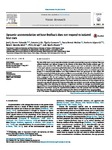Dynamic accommodation without feedback does not respond to isolated blur cues.
| dc.contributor.author | Esteve-Taboada, JJ | en |
| dc.contributor.author | Del Águila-Carrasco, AJ | en |
| dc.contributor.author | Bernal-Molina, P | en |
| dc.contributor.author | López-Gil, N | en |
| dc.contributor.author | Montés-Micó, R | en |
| dc.contributor.author | Kruger, P | en |
| dc.contributor.author | Marín-Franch, I | en |
| dc.date.accessioned | 2018-09-20T17:38:25Z | |
| dc.date.available | 2018-09-20T17:38:25Z | |
| dc.date.issued | 2017-07 | en |
| dc.identifier.uri | http://hdl.handle.net/10026.1/12390 | |
| dc.description.abstract |
The aim of this study was to determine whether dynamic accommodation responds to isolated blur cues without feedback, and without changes in the distance of the object. Nine healthy subjects aged 21-40years were recruited. Four different aberration patterns were used as stimuli to induce blur with (1) the eye's natural, uncorrected, optical aberrations, (2) all aberrations corrected, (3) spherical aberration only, or (4) astigmatism only. The stimulus was a video animation based on computer-generated images of a monochromatic Maltese cross. Each individual video was generated for each subject off-line, after measuring individual aberrations at different accommodation levels. The video simulated sinusoidal changes in defocus at 0.2Hz. Dynamic images were observed through a 0.8mm pinhole placed at a plane conjugated with the eye's pupil, thus effectively removing potential feedback stemming from accommodation changes. Accommodation responses were measured with a Hartmann-Shack aberrometer for the four different aberration patterns. The results showed that seven out of nine subjects did not respond to any stimuli, whereas the response of the other two subjects was erratic and they seemed to be searching rather than following the stimulus. A significant reduction in average accommodative gain (from 0.52 to 0.11) was obtained when the dioptric demand cue was removed. No statistically significant differences were found among the experimental conditions used. We conclude that aberration related blur does not drive the accommodation response in the absence of feedback from accommodation. | en |
| dc.format.extent | 50 - 56 | en |
| dc.language | eng | en |
| dc.language.iso | eng | en |
| dc.subject | Accommodation | en |
| dc.subject | Dynamic accommodation | en |
| dc.subject | Higher-order aberrations | en |
| dc.subject | Vergence | en |
| dc.subject | Accommodation, Ocular | en |
| dc.subject | Adult | en |
| dc.subject | Biofeedback, Psychology | en |
| dc.subject | Cues | en |
| dc.subject | Female | en |
| dc.subject | Humans | en |
| dc.subject | Male | en |
| dc.subject | Refractive Errors | en |
| dc.subject | Young Adult | en |
| dc.title | Dynamic accommodation without feedback does not respond to isolated blur cues. | en |
| dc.type | Journal Article | |
| plymouth.author-url | https://www.ncbi.nlm.nih.gov/pubmed/28619515 | en |
| plymouth.volume | 136 | en |
| plymouth.publication-status | Published | en |
| plymouth.journal | Vision Res | en |
| dc.identifier.doi | 10.1016/j.visres.2017.05.007 | en |
| plymouth.organisational-group | /Plymouth | |
| plymouth.organisational-group | /Plymouth/Faculty of Health | |
| plymouth.organisational-group | /Plymouth/Faculty of Health/School of Health Professions | |
| plymouth.organisational-group | /Plymouth/REF 2021 Researchers by UoA | |
| plymouth.organisational-group | /Plymouth/REF 2021 Researchers by UoA/UoA03 Allied Health Professions, Dentistry, Nursing and Pharmacy | |
| plymouth.organisational-group | /Plymouth/Users by role | |
| plymouth.organisational-group | /Plymouth/Users by role/Academics | |
| dc.publisher.place | England | en |
| dcterms.dateAccepted | 2017-05-29 | en |
| dc.identifier.eissn | 1878-5646 | en |
| dc.rights.embargoperiod | Not known | en |
| rioxxterms.versionofrecord | 10.1016/j.visres.2017.05.007 | en |
| rioxxterms.licenseref.uri | http://www.rioxx.net/licenses/all-rights-reserved | en |
| rioxxterms.licenseref.startdate | 2017-07 | en |
| rioxxterms.type | Journal Article/Review | en |


